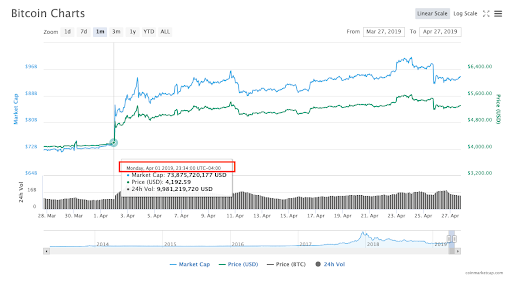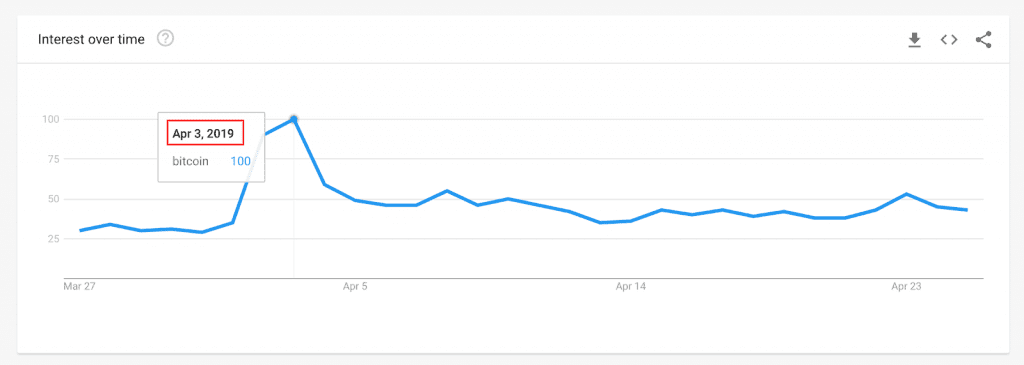Are Tether Fears Good For Bitcoin?
Tether's bad news could be good for Bitcoin prices. Here's why.

Share this article
Looking back on the 2017 bull run, there were three big events which preceded bitcoin’s parabolic rise:
- China banning cryptocurrency
- Extreme Tether uncertainty
- Jamie Dimon swearing to fire any bitcoin trader “in a second.”
In the last month we’ve had China “ban” crypto (again) and a double dose of Tether FUD, so could someone ask Dimon to share his opinion again?
Humor aside, media outlets are once again reporting on falling skies, after the New York Attorney General’s office accused Bitfinex and Tether of covering up $850 million in losses. The announcement has made markets skittish, with some investors already running for the hills.
But the latest Tether accusations might not be the disaster some investors fear.Contrary to popular belief – this could prompt price gains or even a renewed bull run.
Here’s why:
A fall in Tether artificially props up the price of Bitcoin
As Joey Krug, Co-Chief Investment Officer at Pantera and Founder of Augur and Beam, said: “Each crypto bull market typically begins in earnest after some terrible event occurs, I think Bitfinex is that event this time.”
Eric Wall, former Cryptocurrency Lead at Cinnober (acquired by Nasdaq), also noted the connection between Tether’s banking problems and the following bull run. In a tweet last week, Wall said:
Ironically, we may owe the entire bull market of 2017 to Tether. Two years ago on this day, BTCUSD was trading at $1265. As Tether ran into banking problems, CoinMarketCap gave the illusion that bitcoin was rallying. 1 month later the price had doubled. And the rest is history. https://t.co/tRn7URzOOz
— Eric Wall (@ercwl) April 26, 2019
The trick behind that illusion is in CoinMarketCap, whose erroneous calculations can artificially inflate the price of digital currencies. Despite being the leading price aggregator for cryptocurrencies, CMC regularly makes one big mistake: prices in USDT are presented as prices in USD, which means that a fall in the price of Tether could look like an increase in the price of Bitcoin.
It’s simple fractions, and here’s why:
- Suppose that the price of Bitcoin is $1000 USD.
- Suppose further that Tether is trading, on average, at exactly $1.00 USD.
- Finally, suppose the price of Tether falls to $0.99 USD.
In ordinary situations, the price of Bitcoin would not be affected. But since Bitfinex reports its USDT price as a USD price, the following occur:
- The price of BTC on Bitfinex rises to 1010.10 USDT.
- This is reported to CoinMarketCap as a BTC price of $1010.10.
- CoinMarketCap uses a volume-weighted average to determine the price of Bitcoin, which includes Bitfinex’s inflated price.

This calculation makes it look as though the price of Bitcoin is rising, when in reality the price of USDT is falling. It also makes it look as though Bitcoin is much more expensive on Bitfinex, which prompts traders to attempt “arbitrage trades” that further increase the demand and volume on that exchange.
The artificial increase in price and volume has a cyclical impact on Bitcoin’s price. As the price and volume rise, media outlets run more stories about the increasing price and trading opportunities on which retail investors are missing out.
By comparing Google Trends with the price of Bitcoin, we can see that prices rise before spikes in “Bitcoin” searches, and not the other way around. This makes sense because FOMO kicks in. People have busy lives, and once they see the media covering Bitcoin profits that they’re missing out on, they rush to their computers to read (or buy) more.
Here’s an example on April 1st, when bitcoin price increased 15% in 24 hours. Searches for “Bitcoin” on Google reached a peak 2 days later on April 3rd.


More capital could move to “reputable” stablecoins or Bitcoin
Tether has been the largest dollar-valued token since it was introduced to the market, and it’s not even close. The next largest stablecoin (USDC) has only 9% of Tether’s market capitalization, despite the controversy surrounding the latter.
Decreased interest in USDT will have investors moving to more reputable stablecoins that are backed by licensed organizations, such as USDC and the Gemini Dollar, putting funds in arguably safer hands.
In a falling market, investors flock to stablecoins to reduce exposure to Bitcoin. But in a period of market expansion, like the one which has dominated the past few months, holders are likely to move funds out of stablecoins and into Bitcoin, adding more demand and potentially increasing the price.
Last week’s announcement is hardly good news for the world of Bitcoin investors, but it’s not the Tetherpocalypse which doubters have been predicting for over a year. While Bitcoin prices have retreated from the run-up towards $6,000, the fact that BTC is still trading well above $5,000 indicates the cryptocurrency market is far more resilient than its weakest token.
If you need more reassurance that the possible end of Tether doesn’t mean the end for Bitcoin, consider the fact that Bitcoiners have gotten through Mt. Gox, the Bitstamp hack, multiple China bans, the Bitfinex hack and the entire Bitconnect ordeal… And they’re still around to tell the tale.
Share this article
